8444ec14fec9a91768f40c4b4b98b3ba.ppt
- Количество слайдов: 68

Winter Safety Briefing

Winter Safety Briefing You must understand how cold weather effects your vehicle before, during, and after operation.

Winter Safety Briefing Before beginning your journey during wintery weather conditions: • Ask yourself if your journey is absolutely essential. • Check local and national weather forecasts. • Listen to local and national radio for travel information. • Tell someone what time you expect to arrive. • Think about taking warm clothes, boots, and a flashlight – it could be a long walk to a phone. • Clear your windows and mirrors of snow and ice before you set off.

Winter Safety Briefing CLOTHING

Winter Safety Briefing Winter sun Dazzle from winter sun can be dangerous! If it's too low for the visor, it might be worth keeping a pair of sunglasses handy WEAR QUALITY SUNGLASSES Good quality sunglasses help highlight changes in the terrain and road surface, even in low visibility conditions

Winter Safety Briefing Dress Properly v Wear several layers of thick, loose-fitting clothing. v Wear a hat, scarf, and turtleneck sweater. v The head and neck lose heat faster than any other part of the body. v Dress for the cold. v Don’t forget a hat and gloves.

Winter Safety Briefing Prepare the Driver v Wear warm clothes that do not restrict movement. v In bad weather, let someone know your route and intended arrival time, so you can be searched for if you don't turn up after a reasonable delay.

Winter Safety Briefing v Wear several layers of loose fitting, lightweight clothing. v Wear mittens instead of gloves. Wear a hat. v Remember that entrapped, insulating air warmed by body heat is the best protection from the cold.

Winter Safety Briefing Examples of wind chill: With the temperature of 5°F and winds blowing at 35 mph, the wind chill index would be -21°F, which could cause frostbite within 45 minutes. (Increased Danger) Danger With a temperature of -20°F and winds blowing at 35 mph, the wind chill index would be -55°F and could cause frostbite in less than 5 minutes. (Great Danger) Great Danger Read right and down from the calm-air line. For example, a temperature of 0ºF combined with a 20 mph wind, has an equivalent cooling effect of -22ºF.

10

Winter Safety Briefing PREPARE FOR THE TRIP

Winter Safety Briefing Vehicle Preparation Routine precautions help you avoid starting problems: v Get an engine tune-up in the fall v Be sure all lights are in good working order v Have the brakes adjusted v Remember to switch to winter-weight oil if you aren't already using all-season oil v Battery and voltage regulator should be checked ü Dirty oil can give you trouble in the winter, so change the oil and filter. Check the other filters, including the fuel, air and transmission filters.

Winter Safety Briefing Vehicle Preparation Make sure battery connections are good. v If the battery terminal posts seem to be building up a layer of corrosion, clean them with a paste of baking soda and water. Let it foam, and then rinse with water. Apply a thin film of petroleum jelly to the terminal posts to prevent corrosion, and reconnect. Wear eye protection! v Be sure all fluids are at proper levels.

Winter Safety Briefing Vehicle Preparation v Antifreeze should not only be strong enough to prevent freezing, but fresh enough to prevent rust. v Make sure wiper blades are cleaning properly. Consider changing to winter wiper blades, which are made for driving in snow. They are covered with a rubber boot to keep moisture away from working parts of the blade. ü Clean frost and snow off the windows, mirrors, lights and reflectors.

Winter Safety Briefing Vehicle Preparation Carbon monoxide, present in exhaust fumes, is almost impossible to detect and CAN BE FATAL when breathed in a confined area. Because of the danger of carbon monoxide poisoning, don't let your car warm up in the garage for a long period of time, especially if you have an attached garage. The fumes easily can seep into the house and overcome those inside, even with an open garage door. http: //www. phymac. med. wayne. edu/Faculty. Profile/penney/COHQ/co 1. htm

Winter Safety Briefing Vehicle Preparation v The exhaust system: Have the exhaust system checked fully for leaks that could send carbon monoxide into your vehicle. v Heating and cooling system: Check your radiator and hoses for cracks and leaks. Make sure the radiator cap, water pump, and thermostat work properly. Test the strength of the anti-freeze, and test the functioning of the heater and defroster.

Winter Safety Briefing v Windshield: Make sure wipers are in good condition and fill up on winter washer fluid. Keep extra in your trunk. Ensure your windshield can give you clear vision of the road and traffic around you. v One way to find a good repair facility to tune-up your vehicle is to look for an ASI Approved Auto Repair Services sign at garages or ask a friend.

Winter Safety Briefing DON’T FORGET TO FILL UP WITH FUEL

Winter Safety Briefing Here's what you'll want to have on hand, especially in an emergency: v Snow shovel. v Scraper with a brush on one end. v Tow chain or strap. v Warning device (flares or reflective triangles). v Brightly colored cloth to signal for help. v. Don’t forget the gloves. Your fingers will stick to cold metal.

Winter Safety Briefing Here's what you'll want to have on hand, especially in an emergency (Con’t): v Flashlight (with extra batteries) v Abrasive material (cat litter, sand, salt, or traction mats). v Compass, Warning light or road flares, Booster cables v First Aid Kit Keep the headlights on while driving. Don't use your bright lights because the snow can reflect light back into your eyes.

Winter Safety Briefing PREPARE

Winter Safety Briefing v Better understand the dangers of winter storms. v Better identify current and future hazardous weather conditions based on current weather information that is received. v Think critically through a weather situation and make intelligent decisions based on the reliability of that weather information. v Better understand the personal responsibility for one’s decisions during adverse winter weather and the consequences that may follow.

Winter Safety Briefing Winter Deaths Everyone is potentially at risk during winter storms. The actual threat to you depends on your specific situation. Recent observations indicate the following: Related to ice and snow: v About 70% occur in automobiles. v About 25% are people caught out in the storm. v Majority are males over 40 years old.

Weather FLURRIES - Light snow falling for short durations. No accumulation or light dusting is all that is expected. SHOWERS - Snow falling at varying intensities for brief periods of time. Some accumulation is possible. SQUALLS - Brief, intense snow showers accompanied by strong, gusty winds. Accumulation may be significant.

Weather Blowing snow – Wind-driven snow that reduces visibility and causes significant drifting. Blowing snow may be snow that is falling and/or loose snow on the ground picked up by the wind. Heavy snow – 10 cm (4 in. ) or more in 12 hours, or 15 cm (6 in. ) or more in 24 hours, and snow falling reduces visibility up to a quarter of a mile or less.

Weather Snow is frozen precipitation in the form of six-sided crystals. Snow is produced when water vapor is deposited directly into o airborne particles as ice crystals, which remain frozen as they fall. When temperatures remain below freezing from the cloud to the ground, snow results.

Progressing even further away from the warm front, surface temperatures continue to decrease and the sleet changes over to snow

Snowflakes are simply aggregates of ice crystals that collect to each other as they fall toward the surface

Weather Blizzard - The most perilous of winter storms combining falling, blowing, drifting snow, winds of 40 km/hour or more, visibility less than 1 km, temperatures less than – 10 o. C; duration: six hours or more. Cold Wave - A rapid fall in temperature in a short period, requiring greater than normal protective measures. Winds - The cause of blizzard conditions, drifting, reduced visibility and wind-chill effects.

Sleet falls to earth as ice pellets. These ice pellets are formed as snowflakes melt into raindrops as they pass through a thin layer of above-freezing air. The rain drops than refreeze into particles of ice as they pass through a sub -freezing layer of air near the ground.

Weather Progressing further ahead of the warm front, surface temperatures continue to decrease and the freezing rain eventually changes over to sleet. Areas of sleet are located on the colder side (typically north) of the freezing rain band.

Weather Sleet is less prevalent than freezing rain and is defined as frozen raindrops that bounce on impact with the ground or other objects.

Weather Sleet is more difficult to forecast than freezing rain because it develops under more specialized atmospheric conditions. It is very similar to freezing rain in that it causes surfaces to become very slick, but is different because its easily visible.

Weather Visualize a baseball (Hail) dropped from a 747 flying at 30, 000 feet; it's speed reaches 120 MPH, visualize you going 70 MPH under this big ugly cloud. . . bam!

Weather ICE Expect icy conditions any time the outside air temperature reaches 40 o. F or lower. Although water freezes at 32 o. F, road surface can freeze when the air temperature drops to 40 o. F or less. An important place to watch for this condition is on bridges. Bridge surfaces are exposed to the wind and cool off faster than the rest of the road. You should also prepare for icy conditions on roads through shaded areas where a cold wind can freeze a wet road surface.

Weather v Freezing rain is caused by rain droplets that freeze on contact with the ground or objects near the ground, leaving a frozen glaze. The temperature of the ground must be below freezing, and the rain droplets must exist in a liquid state at temperatures below freezing for freezing rain to occur. v Freezing rain can glaze roadways with ice causing extremely hazardous driving conditions.

Weather Ice storms can be the most devastating of winter weather phenomena and are often the cause of automobile accidents, power outages and personal injury. Ice storms result from the accumulation of freezing rain, which is rain that becomes super cooled and freezes upon impact with cold surfaces. Freezing rain is most commonly found in a narrow band on the cold side of a warm gront, where surface temperatures are at or just below freezing.

Weather The diagram below shows a typical temperature profile for freezing rain with the red line indicating the atmosphere's temperature at any given altitude. The vertical line in the center of the diagram is the freezing line. Temperatures to the left of this line are below freezing, while temperatures to the right are above freezing.

DURING OPERATION

Always test your road When you first pull out onto the road, if there is no traffic, you should tap the brakes to see if there is a reaction. Be sure to let off the brakes immediately if the tires slide so you don't lose control. Attempt this a few more times to experiment with how hard you can brake without putting your car into a skid. You can also accelerate a bit to see how much it will take to make the drive wheels spin. Be sure to let off the accelerator if the tires do spin so you don't lose control.

MAINTAIN A COMFORTABLE DRIVING ENVIRONMENT - A constant flow of cool air will help to keep you alert, and keep the windows clear of frost. Keeping one window slightly open will allow you to hear sirens and other warning sounds more quickly. Avoid large bulky boots, gloves, and coats, and never drive in ski boots.

BLIND SPOTS ADJUST MIRROWS v Make sure all windows are clean and there is nothing blocking your vision. v Adjust the seat so you can reach all pedals and controls easily. v Adjust the inside and outside rearview mirrors. v Fasten safety belts and shoulder harnesses so that they are firm and comfortable.

BLIND SPOTS CHECK YOUR BLIND SPOTS BEFORE CHANGING LANES

Seat Belts/ Airbags 1. Unbelted and too close 2. Use seatbelt 3. Recline back of seat 4. Move seat rearward 5. Tilt wheel down 6. Correct belted 10” or more away

Aggressive Driver Aggressive driving can be observed in the following driving patterns: speeding, tailgating, failure to yield, weaving inand-out of traffic, passing on the right, making improper and unsafe lane changes, running stop signs and red lights, making hand facial gestures, screaming, honking, and flashing lights. This type of driving can be associated with being impaired by alcohol or drugs and/or poor anger management.

ANTICIPATE DIFFICULT SITUATIONS - Studies show that 80% of all accidents could be prevented with only one more second to react. In many situations, this one second can be gained by looking far enough down the road to identify problems before you become a part of them.

TURN ON YOUR LIGHTS - Whenever daytime visibility is less than ideal, turning on your lights allows you to see, and to be seen by others. Remember this rule of thumb, Wipers On - Lights On. When traveling in snowy weather, remember to clear tail lights, signal lights, and headlamps regularly.

According to the National Highway Traffic Safety Administration (NHTSA), sport utility vehicles have the highest rollover rate of any vehicle type in fatal crashes: 37 percent as compared with 25 percent for pickups, 19 percent for vans and 15 percent for passenger cars. SUVs also have the highest rollover rate in injury crashes - 9 percent as compared with 7 percent for pickups, 4 percent for vans and 3 percent for cars.

Driver Reaction MANY PEOPLE BELIEVE - that quick reactions make a good driver. The world's best drivers are trained to anticipate problems early and direct the vehicle appropriately before they become involved in a problem. Reacting too quickly can be dangerous if the driver's response is inappropriate.

Pedestrian Traffic Studies have shown that pedestrians walking along a road in dark clothing at night are first seen approximately 55 feet away giving the driver less than one second reaction time. A driver traveling at 60 MPH needs over 260 feet to stop.

Stopping Distance Initial speed Stopping distance Stopping time km/h 40 45 50 55 60 65 70 75 80 90 100 110 120 130 140 150 Meters Feet 36 118 46 151 52 170 62 203 72 236 83 272 95 311 108 354 121 397 150 492 182 597 217 712 256 840 297 974 341 1118 389 1276 seconds 5. 4 6. 0 6. 6 7. 1 7. 7 8. 2 8. 8 9. 3 9. 9 11. 0 12. 1 13. 2 14. 3 15. 4 16. 6 17. 6 mph 25 28 31 34 37 40 44 47 50 56 62 68 75 81 87 93 Stopping Distances and Stopping Times at -2. 5 m/s 2

Adjusting Speed ADJUST YOUR SPEED TO THE CURRENT CONDITIONS - When driving in challenging conditions, SLOW DOWN! Decreasing your speed will allow more time to respond when a difficult situation arises. Factors such as the type of vehicle you are driving, the quality of snow tires your car is equipped with, and your abilities as a driver should all be considered in the speed adjustment.

Wheel Spin Manual transmission car, starting out in 2 nd gear may produce less wheel spin than 1 st gear due to less engine power being applied to the wheels Let up on the accelerator or push in the clutch when you feel the tires break loose and start to spin. When the wheels stop spinning and catch hold, then you apply power again very gently.

WHITE ICE Snow that has been compacted during the day and has slightly melted will freeze at night. Usually this white ice can be seen on the road. When traveling on white ice, drive very slowly. If you cannot find a place to park until conditions improve, install tire chains for better traction. Slick trick -- Watch for slippery spots called glare ice. These may appear on an otherwise clear road in shaded areas. If you see a patch of ice ahead, brake before reaching it and try not to brake while actually on the ice

Black Ice v Black ice fools drivers. Its shine tricks them into thinking it's water on the road. What they may not realize is that condensation, such as dew, freezes when temperatures reach 32 o. F or below. This forms an extra-thin layer of ice on the road. v This shiny ice surface is one of the most slippery road conditions. Black ice is likely to form first under bridges and overpasses, in shady spots and at intersections.

BRAKING The jury is still out on whether rapid pumping of the brake pedal is more effective on slick surfaces than applying a soft steady pressure on the pedal, letting off just before the tires begin to slide. Of course, if the latter method is attempted and the tires do begin to skid, the driver must immediately let off the pedal and recover by steering in the direction of the skid.

Driving in Fog Watch out for fog - it drifts rapidly and is often patchy v Drive very slowly using dipped headlights. v Use fog lights if visibility is seriously reduced, but remember to switch them off when visibility improves. v Don't hang on to the tail lights of the vehicle in front. This gives you a false sense of security and means you may be driving too close. v Don't speed up suddenly - even if it seems to be clearing, you can suddenly find yourself back in thick fog.

Driving in Fog When do I use Fog Lights? Fog lights are designed to be used during fog or foul weather, in conjunction with your low beams to focus as much light as possible on the ground directly in front of you. Providing increased light on the ground helps you to follow the road and helps reduce the reflection on the fog from your headlights.
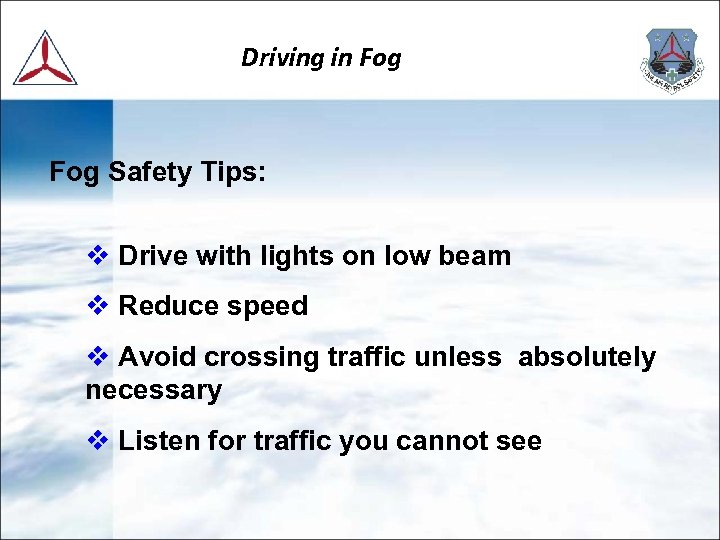
Driving in Fog Safety Tips: v Drive with lights on low beam v Reduce speed v Avoid crossing traffic unless absolutely necessary v Listen for traffic you cannot see

Driving in Fog Safety Tips (Con’t): v Use wipers and defroster as necessary for maximum vision. v Be patient! Don’t pass lines of traffic. v Unless absolutely necessary, don’t stop on any freeway or other heavily traveled road. v Consider postponing your trip until the fog clears.
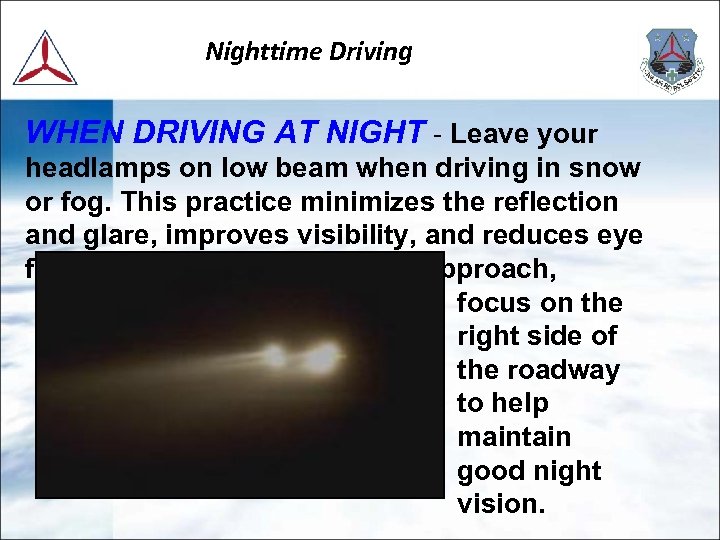
Nighttime Driving WHEN DRIVING AT NIGHT - Leave your headlamps on low beam when driving in snow or fog. This practice minimizes the reflection and glare, improves visibility, and reduces eye fatigue. When oncoming cars approach, focus on the right side of the roadway to help maintain good night vision.

Risk Management Reminders Prepare a Driver v If you must drive in bad weather, plan ahead and make sure you have enough fuel. v See and be seen; clear all snow from the hood, roof, windows and lights. v Clear all windows of fog and moisture. v If visibility becomes poor, find a place to safely pull off the road as soon as possible.
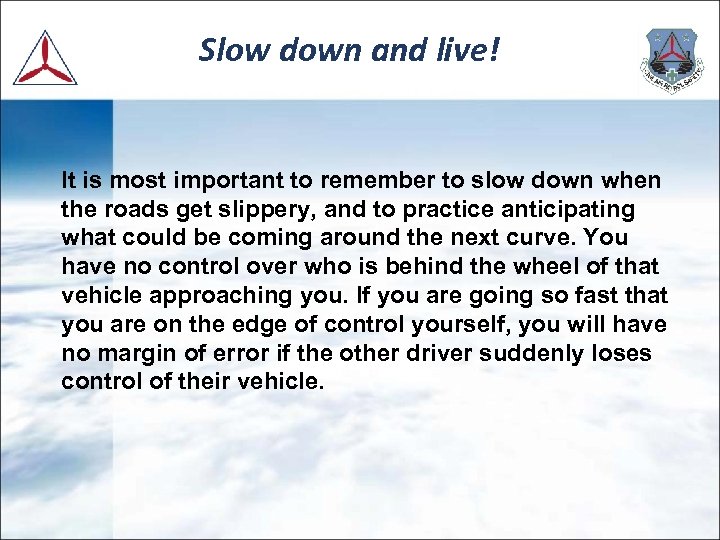
Slow down and live! It is most important to remember to slow down when the roads get slippery, and to practice anticipating what could be coming around the next curve. You have no control over who is behind the wheel of that vehicle approaching you. If you are going so fast that you are on the edge of control yourself, you will have no margin of error if the other driver suddenly loses control of their vehicle.
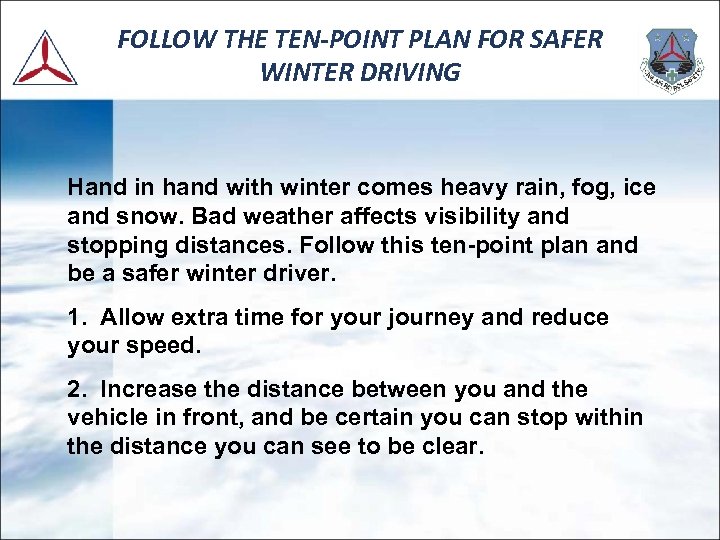
FOLLOW THE TEN-POINT PLAN FOR SAFER WINTER DRIVING Hand in hand with winter comes heavy rain, fog, ice and snow. Bad weather affects visibility and stopping distances. Follow this ten-point plan and be a safer winter driver. 1. Allow extra time for your journey and reduce your speed. 2. Increase the distance between you and the vehicle in front, and be certain you can stop within the distance you can see to be clear.
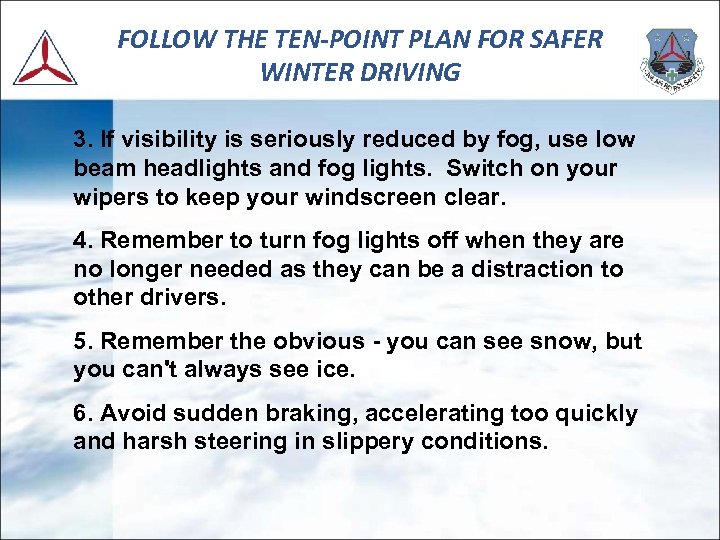
FOLLOW THE TEN-POINT PLAN FOR SAFER WINTER DRIVING 3. If visibility is seriously reduced by fog, use low beam headlights and fog lights. Switch on your wipers to keep your windscreen clear. 4. Remember to turn fog lights off when they are no longer needed as they can be a distraction to other drivers. 5. Remember the obvious - you can see snow, but you can't always see ice. 6. Avoid sudden braking, accelerating too quickly and harsh steering in slippery conditions.
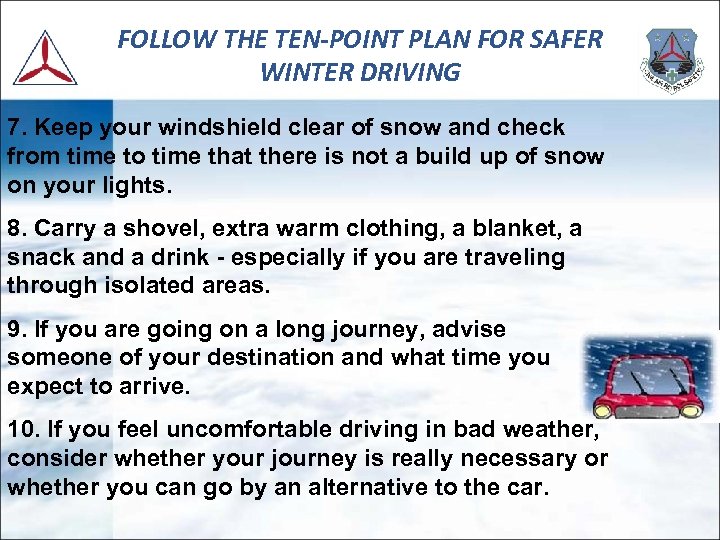
FOLLOW THE TEN-POINT PLAN FOR SAFER WINTER DRIVING 7. Keep your windshield clear of snow and check from time to time that there is not a build up of snow on your lights. 8. Carry a shovel, extra warm clothing, a blanket, a snack and a drink - especially if you are traveling through isolated areas. 9. If you are going on a long journey, advise someone of your destination and what time you expect to arrive. 10. If you feel uncomfortable driving in bad weather, consider whether your journey is really necessary or whether you can go by an alternative to the car.
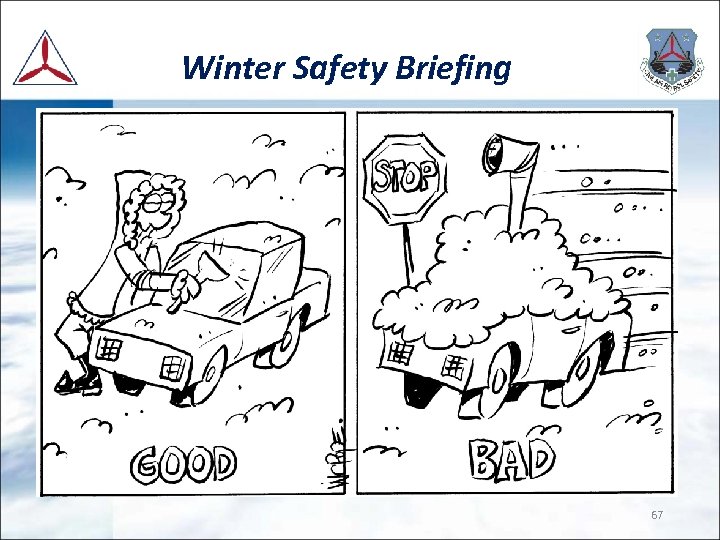
Winter Safety Briefing 67
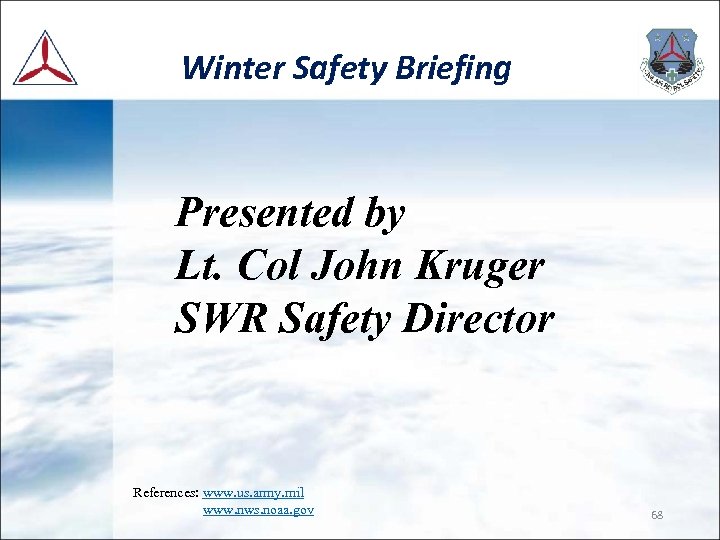
Winter Safety Briefing Presented by Lt. Col John Kruger SWR Safety Director References: www. us. army. mil www. nws. noaa. gov 68
8444ec14fec9a91768f40c4b4b98b3ba.ppt